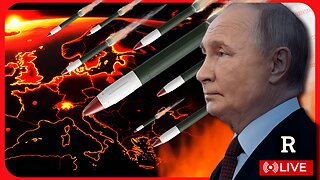Premium Only Content

Innovation Needed: Ablative Techniques in Cancer Therapy
The future of cancer treatment demands innovation—especially in ablative techniques that activate the immune system.
Today, let’s rank some of the key ablative techniques from best to least effective for immune activation:
👉 Top Ablative Techniques for Immune Activation:
1. Nanopulsed Electric Field Therapy (PEF): 💥 Non-thermal, innovative, and used here at Williams Cancer Institute. PEF creates new dead cell antigens, effectively turning cancer into its own worst enemy by rallying the immune system.
2. Cryoablation: ❄️ Rapid freezing and thawing of the tumor, preserving new antigens for immune activation while keeping it non-thermal.
3. Irreversible Electroporation (IRE): ⚡ A milder version of nanopulsed PEF, poking holes in cell membranes to expose cancer antigens.
4. Photodynamic Therapy (PDT): 🔆 Uses specific light wavelengths to destroy tumor cells, preserving antigens for immune activation.
5. High-Intensity Focused Ultrasound (HIFU) / Histotripsy: 🎯 Though effective, these techniques introduce thermal activity, reducing antigen availability.
6. Radiofrequency Ablation (RFA) & Microwave Ablation: 🔥 More thermal activity, which means fewer antigens preserved for immune system activation.
7. Laser Interstitial Thermal Therapy (LITT): ⚡ Laser-based and thermal—effective but results in fewer antigens for immune response.
8. Electrochemotherapy: 💊 Hyperactivates chemotherapy without an immune activation component.
Innovation isn’t just a buzzword here at Williams Cancer Institute—it’s our mission. By leveraging these advanced ablative techniques, we aim to maximize immune activation while minimizing collateral damage.
Supporting Evidence:
* Van den Bijgaart RJ, Eikelenboom DC, Hoogenboom M, et al. Thermal and mechanical high-intensity focused ultrasound: perspectives on tumor ablation, immune effects, and combination strategies. Cancer Immunol Immunother.2017;66(2):247-258. doi:10.1007/s00262-016-1891-9. Available at: https://link.springer.com/article/10.1007/s00262-016-1891-9
* Guo RQ, Guo XX, Li YM, et al. Cryoablation, high-intensity focused ultrasound, irreversible electroporation, and vascular-targeted photodynamic therapy for prostate cancer: a systemic review and meta-analysis. Int J Clin Oncol.2021;26(3):461-484. doi:10.1007/s10147-020-01847-y. Available at: https://link.springer.com/article/10.1007/s10147-020-01847-y
* Ahmed M, Kumar G, Moussa M, et al. Image-guided tumor ablation: standardization of terminology and reporting criteria—a 10-year update. J Vasc Interv Radiol. 2014;25(11):1691-1705. doi:10.1016/j.jvir.2014.08.027. Available at: https://www.jvir.org/article/S1051-0443(14)00821-4/fulltext
* Dromi SA, Walsh MP, Herby S, et al. Radiofrequency ablation induces antigen-presenting cell infiltration and amplification of weak tumor-induced immunity. Radiology. 2009;251(1):58-66. doi:10.1148/radiol.2511081103. Availableat: https://pubs.rsna.org/doi/full/10.1148/radiol.2511081103
* Chu KF, Dupuy DE. Thermal ablation of tumours: biological mechanisms and advances in therapy. Nat Rev Cancer.2014;14(3):199-208. doi:10.1038/nrc3672. Available at: https://www.nature.com/articles/nrc3672
Ready to take charge of your health? Click the link in my bio to learn more about how we can help.
#CancerInnovation #AblativeTherapy #ImmuneActivation #CancerTreatment #PulseElectricField #Cryoablation #CancerCare #WilliamsCancerInstitute #IntegrativeOncology #CuttingEdgeCancerTherapy #HopeForCancer #ThermalAblation #CancerResearch #FightingCancerTogether
-
 46:21
46:21
PMG
23 hours ago $0.10 earned"Venezuelan Gang in 16 States, Animal Testing Crackdown, & Trump’s Nominee Battle"
15.4K7 -
 LIVE
LIVE
VOPUSARADIO
9 hours agoPOLITI-SHOCK! WW3!?, BREAKDOWN OF THE WORLD EVENTS & R.A.G.E. (What it means & What's next!)
212 watching -
 1:00:10
1:00:10
The StoneZONE with Roger Stone
7 hours agoWhy Democrats Hold Poor Children Hostage in Failing Schools | The StoneZONE w/ Roger Stone
42.6K6 -
 LIVE
LIVE
Tundra Gaming Live
7 hours ago $0.12 earnedThe Worlds Okayest War Thunder Stream//Air Force Vet Flys Jets
246 watching -
 2:00:54
2:00:54
Redacted News
8 hours agoBREAKING! Putin just SHOCKED the world, launches nuclear capable warheads "NATO can't stop it"
179K516 -
 55:37
55:37
Candace Show Podcast
8 hours agoMatt Gaetz Out, Jussie Smollett Walks Free! | Candace Ep 108
141K348 -
 54:43
54:43
LFA TV
1 day agoTrump Has Learned His Lesson | Trumpet Daily 11.21.24 7PM EST
34.7K9 -
 1:02:42
1:02:42
theDaily302
15 hours agoThe Daily 302-Special Border Invasion Shutdown Show
21.1K3 -
 4:29:05
4:29:05
Tate Speech by Andrew Tate
15 hours agoEMERGENCY MEETING EPISODE 92 - IN THE TRENCHES
789K1.36K -
 1:01:23
1:01:23
In The Litter Box w/ Jewels & Catturd
1 day agoThe Trump Effect | In the Litter Box w/ Jewels & Catturd – Ep. 696 – 11/21/2024
95.4K42